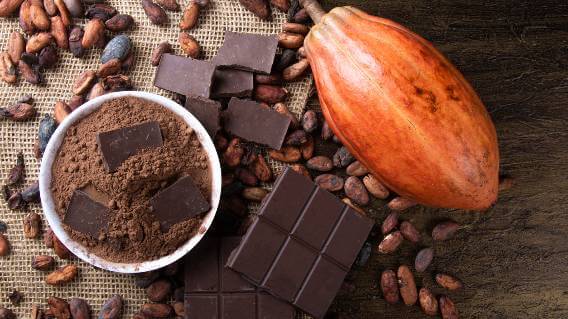Hershey’s, Trader Joe’s Face Lawsuits Over Heavy Metals in Chocolate
Editors carefully fact-check all Consumer Notice, LLC content for accuracy and quality.
Consumer Notice, LLC has a stringent fact-checking process. It starts with our strict sourcing guidelines.
We only gather information from credible sources. This includes peer-reviewed medical journals, reputable media outlets, government reports, court records and interviews with qualified experts.

The Hershey Company and Trader Joe’s are facing separate class-action lawsuits alleging some of their dark chocolate bars contain lead and cadmium.
These lawsuits follow a December 2022 report on heavy metals in dark chocolate by Consumer Reports. The study found lead and cadmium in all of the 28 bars tested.
Five of the bars contained safe levels of these heavy metals. The other 23 bars contained potentially harmful levels of heavy metals for adults who consume one ounce a day.
People choose dark chocolate for its reported health benefits. Studies have found it contains high levels of antioxidants and low levels of sugar. It may prevent cardiovascular disease, improve heart health and boost the regulation of blood pressure, insulin levels and fat metabolism.
Long-term exposure to small amounts of heavy metals in harmful products may cause serious health effects. The risk is greatest among pregnant women and young children. Heavy metals may cause developmental problems, impact brain development and contribute to a lower IQ.
In adults, lead exposure may cause kidney damage, reproductive issues, high blood pressure, immune system suppression and nervous system problems.
Both class-action lawsuits seek at least $5 million in damages, including at least $500 per transaction under New York law. Lawyers filed the lawsuits in late December and early January in the U.S. District Court for the Eastern District of New York in Central Islip, New York.
Some Dark Chocolate Deemed Safe
Not all dark chocolate products contain potentially harmful levels of heavy metals. The study by Consumer Reports showed five of the 28 bars tested were safe.
“That shows it’s possible for companies to make products with lower amounts of heavy metals — and for consumers to find safer products that they enjoy,” said Tunde Akinleye, a food safety researcher at Consumer Reports who led the study.
The safe dark chocolate in the study included bars made by Ghirardelli, Mast, Taza Chocolate and Valrhona.
Many Brands Contain High Levels of Heavy Metals
Brands with bars containing high levels of lead, cadmium or both in the study included Dove, Godiva, Hershey’s, Lindt and Trader Joe’s.
The lawsuits include the following brands and chocolate bars:
- Alter Eco Organic Dark Chocolate Classic Blackout 85% Cacao
- Beyond Good Organic Pure Dark Chocolate 70% Cocoa
- Beyond Good Organic Pure Dark Chocolate 80% Cocoa
- Chocolove Strong Dark Chocolate 70% Cocoa
- Chocolove Extreme Dark Chocolate 88% Cocoa
- Dove Promises Deeper Dark Chocolate 70% Cacao
- Endangered Species Bold + Silky Dark Chocolate 72% Cocoa
- Equal Exchange Organic Extra Dark Chocolate 80% Cacao
- Godiva Signature Dark Chocolate 72% Cocoa
- Green & Black’s Organic Dark Chocolate 70% Cacao
- Hershey’s Special Dark Mildly Sweet Chocolate
- Hu Organic Simple Dark Chocolate 70% Cacao
- Lily’s Extra Dark Chocolate 70% Cocoa
- Lily’s Extremely Dark Chocolate 85% Cocoa
- Lindt Excellence Dark Chocolate 70% Cocoa
- Lindt Excellence Dark Chocolate 85% Cocoa
- Pascha Organic Very Dark Dark Chocolate 85% Cacao
- Scharffen Berger Extra Dark Chocolate 82% Cacao
- Theo Organic Pure Dark 70% Cocoa
- Theo Organic Extra Dark Pure Dark Chocolate 85% Cocoa
- Tony’s Chocolonely Dark Chocolate 70% Cocoa
- Trader Joe’s Dark Chocolate 72% Cacao
- Trader Joe’s The Dark Chocolate Lover’s Chocolate 85% Cacao
California’s maximum allowable dose level for lead (0.5 micrograms) and cadmium (4.1 micrograms) was used for the Consumer Reports study.
The U.S. Food and Drug Administration has a higher allowable dose level for lead. It limits daily lead intake to 2.2 micrograms for children and 8.8 micrograms for women of childbearing age.
How Heavy Metals Contaminate Chocolate
A three-year study published in August 2022 revealed that lead and cadmium get into cacao beans in different ways. This requires separate solutions to reduce each type of metal.
Cacao plants take up cadmium from the soil. The roots absorb cadmium and deposit it inside the cacao beans. The metal accumulates in the beans as the tree grows.
Lead contamination takes place after the harvesting of the cacao beans. The outer shell of wet beans gets contaminated with lead as the beans dry and ferment outdoors. Lead-contaminated soil and dust adhere to the beans during the drying, fermenting and transportation phases of production.
The study resulted from a legal settlement involving the National Confectioners Association and As You Sow. The confectioners association represents chocolate manufacturers. As You Sow is a nonprofit organization that promotes corporate responsibility for environmental and social issues.
Experts, including Consumer Report’s researcher Akinleye, recommend eating dark chocolate in moderation to reduce exposure to heavy metals.
“Having a serving a few days a week, especially with a product that has lower levels, means you can eat dark chocolate without worrying unduly,” said Akinleye.